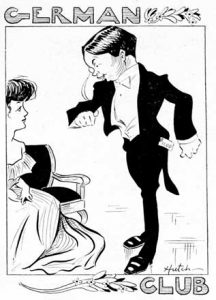A UNC grad and former student assistant of ours recently shared with us some information that may explain the origins of a term much in use at the University through about the first half of the twentieth century. Some of the student dances at UNC were called Germans. There was usually a Fall German and a Spring German. The dances were organized by a German Club, but so far as we can tell, the club had nothing to do with Germany or the German language. So, where did the name come from? Katie Littlefield emailed us that while doing research on customs and traditions at the University she discovered a passage in Phillips Russell’s These Old Stone Walls claiming that dances at Chapel Hill in antebellum times were called balls. After the Civil War they were called Germans, “…led by gentlemen who could carry out elaborate cotillion figures.” While cotillion dances had dropped out of fashion in the early nineteenth century, Katie notes that they were reintroduced in New York society in 1854 and called “German cotillions.” Could the University’s Germans be a long-forgotten abbreviation of German cotillion? We think it may well be so. How about you?
The image above is from the 1906 Yackety Yack.


Harry is right. A “German” was a form of figure or social dancing, also known as a “cotillion.” (Think, “high-brow square dancing.” ) Over time, the term cotillion came to be given to the event rather than the dance, and a specific form of cotillion, the “German Cotillion” even came to substitute for the more general term for the type of dance. “German Clubs” existed not only in colleges but in communities, and they usually sponsored two or three major social events, “Germans” each year.
Here you see the original “Dance Card” of a German miss:
http://drtlibrary.wordpress.com/2009/05/27/may-i-have-this-dance/
Ralf
An addendum: In addition to holding its own dances, the German Club at UNC came to control all of the dances on campus. When the Di and Phi stopped exerting control over student behavior and campus-wide social activities in the early 1900s, a void in student governance was left. The Student Council, which replaced the Di and Phi as studet government beginning in 1904, did not extend its reach over social activities. UNC dances became a bit rowdy and villagers complained and subsequently their complaints drew the attention of leaders in the state. The German Club, an exclusive interfraternity group, managed the grandest dances at the time, and the faculty placed these members in charge of all dances on campus no matter the sponsoring student group–even though they were self-selecting in their membership. The GErman Club even came to choose the Commencement Marshals, since one of the jobs of marshals then was to lead the formations in the Commencement Ball. This brought about better controlled dances, but rubbed many Carolina students the wrong way because most o them had no say in who would control the major social activities on campus. Law students held a dance in 1932, and the German Club asserted its right of control over this gathering. There was, apparently, some conflict engendered. There was a backlash against the control led by the Phi Society and its Speaker, Ed Lanier, who had also been one of the organizers of the law student dance. Lanier later went on to be the longtime registrar of the University.